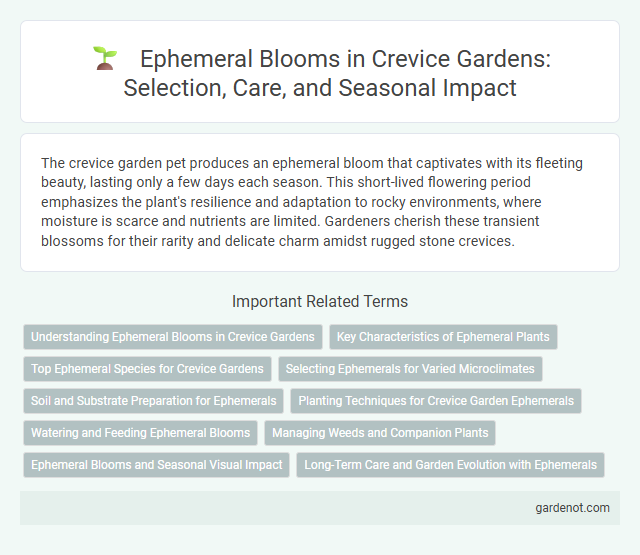The crevice garden pet produces an ephemeral bloom that captivates with its fleeting beauty, lasting only a few days each season. This short-lived flowering period emphasizes the plant's resilience and adaptation to rocky environments, where moisture is scarce and nutrients are limited. Gardeners cherish these transient blossoms for their rarity and delicate charm amidst rugged stone crevices.
Understanding Ephemeral Blooms in Crevice Gardens
Ephemeral blooms in crevice gardens thrive by taking advantage of the unique microhabitats created by rock fissures, where moisture retention and temperature regulation support rapid flowering cycles. These short-lived blooms, often from alpine and rock garden species, have evolved to complete their reproductive processes quickly in response to fleeting favorable conditions. Understanding the timing and environmental triggers of ephemeral blooms allows gardeners to optimize plant selection and garden maintenance for sustained visual impact.
Key Characteristics of Ephemeral Plants
Ephemeral plants in crevice gardens are characterized by their rapid life cycle, allowing them to bloom quickly and complete seed production before harsh conditions arise. These plants often exhibit drought tolerance and thrive in minimal soil, making them ideal for the shallow, rocky crevices that mimic mountainous terrain. Their brief but vibrant flowering period contributes to the dynamic seasonal display of a crevice garden, enhancing biodiversity and ecological resilience.
Top Ephemeral Species for Crevice Gardens
Top ephemeral species ideal for crevice gardens include Claytonia sibirica, known for its vibrant spring blooms and rapid life cycle, and Erythronium americanum, which thrives in rocky, well-drained soil while providing striking yellow flowers. Cardamine concatenata adds delicate white blossoms early in the season, enhancing the garden's seasonal interest. These species capitalize on short growth periods, making them perfect for the unique microhabitats within crevice gardens.
Selecting Ephemerals for Varied Microclimates
Selecting ephemerals for a crevice garden involves choosing plants like Claytonia lanceolata, Erythronium spp., and Anemone nemorosa, which thrive in diverse microclimates within rock crevices. These species adapt well to shallow soils, varying moisture levels, and fluctuating sunlight, ensuring seasonal bursts of color. Their rapid life cycles and compact root systems complement the unique conditions of crevice gardens, promoting sustained ecological balance and visual interest.
Soil and Substrate Preparation for Ephemerals
Ephemeral blooms thrive in well-drained, nutrient-rich soil with a high organic matter content, essential for quick root establishment and growth during their brief life cycle. Incorporating coarse sand or fine gravel improves substrate aeration and prevents waterlogging, which is critical for bulbs and tubers sensitive to excess moisture. Proper soil pH, typically slightly acidic to neutral (6.0-7.0), enhances nutrient availability and supports optimal ephemeral plant development in crevice garden environments.
Planting Techniques for Crevice Garden Ephemerals
Ephemeral plants in crevice gardens require precise planting techniques that maximize root access to narrow soil pockets while ensuring adequate drainage. Utilizing a mix of gritty, well-draining substrates like crushed granite or sand encourages healthy root development and prevents waterlogging in tight spaces. Positioning bulbs or tubers at varying depths within crevices mimics natural alpine conditions, promoting staggered bloom periods and lasting visual interest.
Watering and Feeding Ephemeral Blooms
Ephemeral blooms in crevice gardens require precise watering to mimic natural rainfall, avoiding over-saturation while maintaining consistent moisture levels. Feeding should involve balanced, diluted fertilizers high in phosphorus to promote vibrant flowering without encouraging excessive foliage growth. Timely irrigation combined with targeted nutrient application supports the short, intense bloom period typical of these delicate plants.
Managing Weeds and Companion Plants
Ephemeral bloom in crevice gardens requires strategic management of weeds to maintain optimal growth conditions and nutrient availability. Companion plants such as sedums and alpine herbs not only suppress weed proliferation but also enhance soil moisture retention and biodiversity. Effective weed control combined with carefully selected companion species promotes healthy ephemeral blooms and sustains the delicate ecosystem unique to crevice garden environments.
Ephemeral Blooms and Seasonal Visual Impact
Ephemeral blooms in crevice gardens create striking, seasonal visual impact by emerging briefly during optimal climates, showcasing vibrant colors and delicate textures that highlight the garden's natural rock formations. These short-lived flowers adapt to the thin soil layers within crevices, maximizing growth cycles to deliver bursts of beauty that refresh garden aesthetics each season. Their transient nature encourages dynamic planting strategies that enhance biodiversity and maintain year-round interest with rotating floral displays.
Long-Term Care and Garden Evolution with Ephemerals
Ephemeral blooms in crevice gardens require attentive long-term care to ensure soil consistency and moisture retention within narrow gaps, promoting sustainable growth cycles. Regular monitoring of microclimates around crevices allows adaptive maintenance, fostering gradual garden evolution with seasonal shifts in ephemeral species. This strategic approach enhances biodiversity and dynamic visual interest, aligning with natural phenology for enduring crevice garden vitality.
Ephemeral bloom Infographic

 gardenot.com
gardenot.com